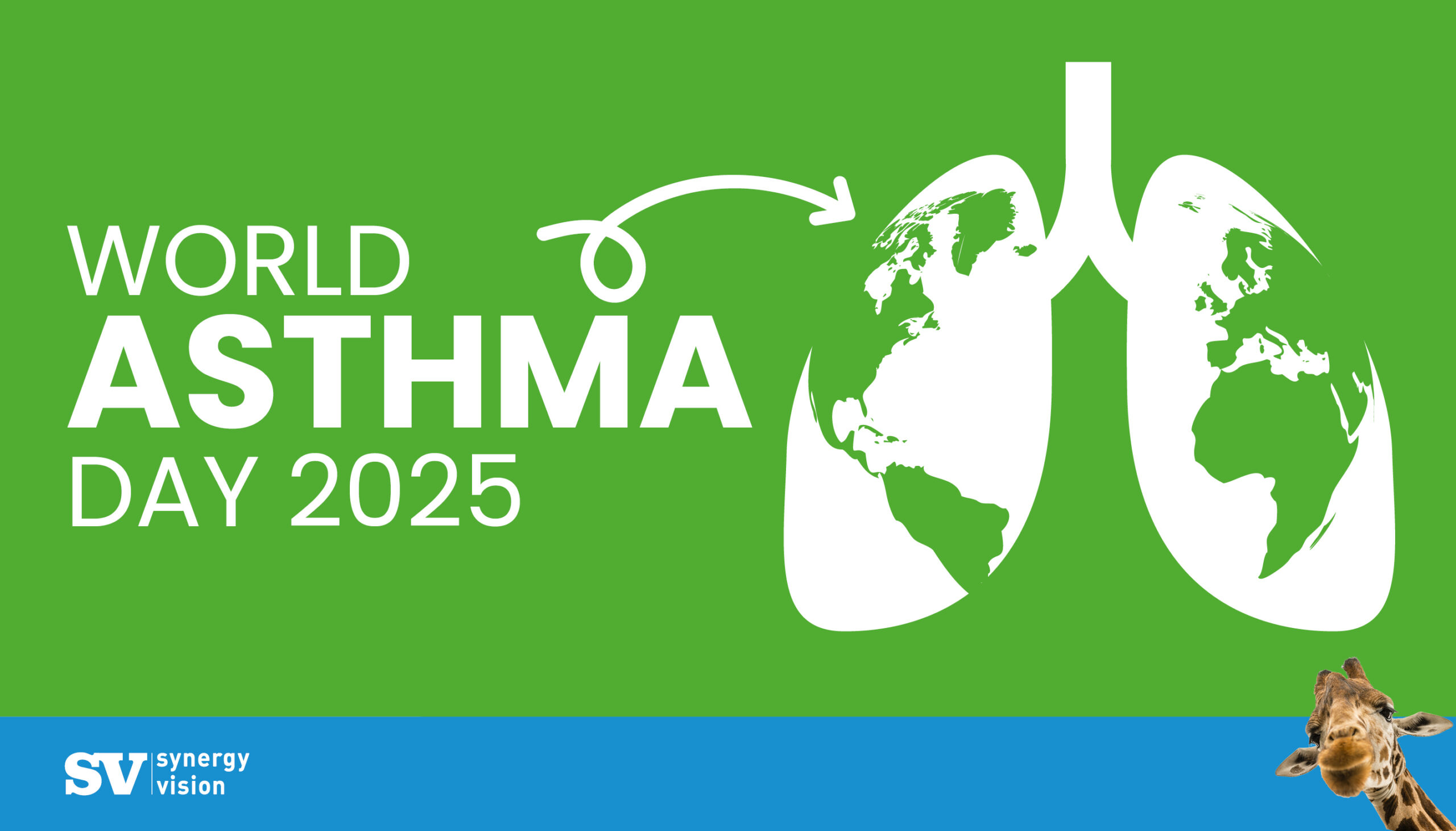Biologics are unlocking a personalized path for patients with asthma
This week, in recognition of World Asthma Day, we’re not just imagining the future of asthma care – we’re living through its transformation. Over the past two decades, the introduction and advancement of targeted biologic therapies have significantly changed the landscape for people with severe asthma. After more than 50 years of relying heavily on corticosteroids, we are now moving toward a new era of precision medicine.
With 18 years in the respiratory space under our belt (click here to see the kind of work that we’ve been doing!), our team at Synergy Vision are continuously evaluating the treatment landscape and looking for future trends in asthma care: In this post, we explore how asthma care continues to evolve towards precision medicine.
From steroids to biologics: Moving beyond symptom management
Asthma affects >260 million people worldwide, placing a significant burden on individuals and healthcare systems alike.¹ For those with severe asthma (which affects ~200,000 people in the UK),2 standard therapies, such as high-dose inhaled corticosteroids, long-acting beta agonists, and long-acting muscarinic antagonists, often fall short in achieving adequate symptom control, with frequent exacerbations remaining common.³ For many years, oral corticosteroids were the mainstay for managing uncontrolled symptoms and acute exacerbation, despite their well-documented long-term side effects, including osteoporosis, diabetes, and hypertension.³ In recent decades, the emergence of targeted biologic therapies has provided long-overdue hope for patients burdened by uncontrolled, chronic asthma, helping to reduce reliance on oral corticosteroids, and improving disease outcomes.
Personalized medicine: Tailoring treatment for real symptom control
Asthma is a highly heterogenous disease, demanding personalized approaches informed by clinical characteristics and biomarkers relevant to the underlying disease pathogenesis.4
Severe asthma is broadly classified into two main types: type 2 (T2) inflammation and non-T2 inflammation. T2 inflammation can be further sub-categorized into allergic and eosinophilic asthma, each associated with distinct biomarkers, such as fractional exhaled nitric oxide, blood eosinophil counts, and immunoglobulin E levels.5,6
Conversely, non-T2 asthma (including neutrophilic asthma) is often characterized by the absence or low levels of these T2 inflammatory biomarkers and a poor response to corticosteroids.7 This form of asthma remains more difficult to treat and lacks the same breadth of targeted therapies.5
Nevertheless, our understanding of asthma continues to evolve. Future advances in identifying inflammatory pathways, along with deeper insights into asthma phenotypes and endotypes, should help to bridge these knowledge gaps and pave the way for more precise and individualized treatment – ensuring patients receive the right therapy at the right time. Among these advances, biologic therapies have emerged over the past two decades as key treatment options for patients with severe asthma, offering a more targeted and personalized approach that goes beyond symptom control to potentially modify the underlying disease process.
Biologics: Redefining asthma care for the future
Biologics are advanced therapies that disrupt specific immune pathways to reduce inflammation. By doing so, they have been shown to improve lung function, lower exacerbation rates, and reduce dependence on oral corticosteroids, crucially, minimizing long-term side effects and improving quality of life.8
Several biologic therapies have already been approved by the European Medicines Agency for the treatment of severe eosinophilic and allergic asthma, including omalizumab, mepolizumab, reslizumab, benralizumab, dupilumab, and tezepelumab. In recognition of their therapeutic potential and to reduce reliance on oral corticosteroids, NHS England has identified ‘Asthma Biologics’ as a Rapid Uptake Product as part of the NHS Long Term Plan, which aims to improve outcomes for patients with respiratory disease.9
Exciting recent findings from a Phase 2, double-dummy, active placebo-controlled randomized trial conducted in the UK, demonstrated that benralizumab, when repurposed for use in emergency settings, was more effective than standard oral corticosteroids for acute eosinophilic asthma exacerbations, and could potentially reduce the need for further treatment and hospitalizations.10 With a single hospital admission for asthma costing the NHS between £1,516 and £2,473 per night,11 this highlights not just the versatility of biologic therapies, but their potential to substantially reduce the burden that emergency asthma care places on our already stretched healthcare systems.
The future of asthma care: Beyond symptom control
The outlook for asthma is brighter than ever. Our evolving understanding of the underlying mechanisms of disease, combined with the therapeutic power of biologic therapies, is moving us beyond simple, often ineffective, symptom management, and towards personalized, disease-modifying care.
Identifying specific asthma phenotypes and endotypes will allow physicians to select the most appropriate biologic therapy for each patient, improving outcomes, reducing exacerbations, and transforming lives.
Yet, challenges remain. Firstly, treatment options for patients with severe non-eosinophilic asthma are still limited. While targets for novel biologic therapies, such as interleukin-17 and interleukin-23, have been explored, research to date has generated mixed results regarding their efficacy. Further investment and innovation are urgently needed to develop effective treatments for this difficult-to-treat population.12 Secondly, despite their significant therapeutic effects, the high cost of biologic therapies remains a major barrier to their widespread adoption. For instance, a single dose of omalizumab is priced at £512.30, with a 24-week course costing the NHS up to £3,073.80.13 In future, the overall cost of biologic therapies is expected to decline as lower-cost biosimilars enter the market.14 Lastly, given the significant overlap in therapeutic indications, it can be challenging for physicians to know which biologic therapy to initiate first where multiple treatment options are available.15
Nevertheless, after decades of dependence on corticosteroids, we are steadily progressing toward a new era in asthma care – one defined by more targeted and personalized approaches. This World Asthma Day is a moment to reflect on how biologics are redefining what’s possible for patients with severe asthma. At Synergy Vision, we’ve had the privilege of partnering with our clients across a broad range of respiratory diseases (including asthma and COPD) and we remain committed to delivering deeper insights and clearer communication, supporting our clients in the pursuit of long-term disease modification and lasting improvements in the quality of life of patients around the world. Click here to see what we’ve been up to lately here at Synergy Vision!
References
- World Health Organization. Asthma. https://www.who.int/news-room/fact-sheets/detail/asthma. Published May 2024. Accessed April 2025.
- Asthma + Lung UK. What is severe asthma? https://www.asthmaandlung.org.uk/conditions/severe-asthma/what-severe-asthma. Updated November 2022. Accessed April 2025.
- Global Initiative for Asthma. Difficult-to-treat & severe asthma. https://ginasthma.org/wp-content/uploads/2019/04/GINA-Severe-asthma-Pocket-Guide-v2.0-wms-1.pdf. Published April 2019. Accessed April 2025.
- Charriot J, Vachier I, Halimi L, et al. Future treatment for asthma. Eur Respir Rev. 2016;25:77–92. doi: 10.1183/16000617.0069-2015.
- American Lung Association. Severe Asthma. https://www.lung.org/lung-health-diseases/lung-disease-lookup/asthma/learn-about-asthma/types/severe-asthma. Updated March 2025. Accessed April 2025.
- Busse WW. Biological treatments for severe asthma: A major advance in asthma care. Allergol Int. 2019;68:158–66. doi: 10.1016/j.alit.2019.01.004.
- Liu T, Woodruff PG, Zhou X. Advances in non-type 2 severe asthma: From molecular insights to novel treatment strategies. Eur Respir J. 2024;64:2300826. doi: 10.1183/13993003.00826-2023.
- Rupani H, Murphy A, Bluer K, et al. Biologics in severe asthma: Which one, when and where? Clin Exp Allergy. 2021;51:1225–8. doi: 10.1111/cea.13989.
- NHS England. Asthma Biologics – Rapid Uptake Product. https://www.england.nhs.uk/aac/what-we-do/innovation-for-healthcare-inequalities-programme/rapid-uptake-products/asthma-biologics/. Accessed April 2025.
- Ramakrishnan S, Russell REK, Mahmood HZ, et al. Treating eosinophilic exacerbations of asthma and COPD with benralizumab (ABRA): A double-blind, double-dummy, active placebo-controlled randomised trial. Lancet Respir Med. 2025;13:59–68. doi: 10.1016/S2213-2600(24)00299-6.
- NHS England. Respiratory high impact interventions. https://www.england.nhs.uk/ourwork/prevention/secondary-prevention/respiratory-high-impact-interventions/. Accessed April 2025.
- Pelaia C, Pelaia G, Crimi C, et al. Novel biological therapies for severe asthma endotypes. Biomedicines. 2022;10:1064. doi: 10.3390/biomedicines10051064.
- British National Formulary. Omalizumab Medical forms. https://bnf.nice.org.uk/drugs/omalizumab/medicinal-forms/. Accessed April 2025.
- Russell MD, Galloway JB. Driving down the cost of biologics: Lessons from a nationalised health-care system. Lancet. 2024;404:1723–4. doi: 10.1016/S0140-6736(24)02151-2.
- Kavanagh JE, Hearn AP, Jackson DJ. A pragmatic guide to choosing biologic therapies in severe asthma. Breathe (Sheff). 2021;17:210144. doi: 10.1183/20734735.0144-2021.

